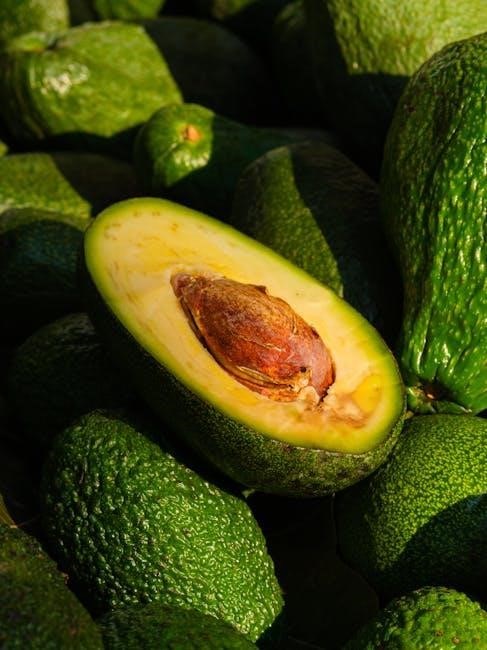interpreting a food web answer key pdf

Food webs represent complex networks showing how species interact through feeding relationships, essential for understanding ecosystems. They include producers, consumers, and decomposers, with arrows indicating energy flow directions. Analyzing food webs reveals ecological balance and biomagnification effects, crucial for conservation strategies.
1.1 Definition and Importance of Food Webs
A food web is a network of interconnected food chains that illustrate the feeding relationships within an ecosystem. It represents how energy and nutrients flow from producers to consumers and decomposers. Unlike food chains, food webs show multiple pathways, highlighting the complexity of ecological interactions. Understanding food webs is crucial for analyzing ecosystem stability, as they reveal how species depend on one another. They also help identify keystone species, which play vital roles in maintaining ecological balance. Food webs are essential tools for studying energy flow, trophic levels, and nutrient cycling, making them fundamental in ecology and conservation biology. By interpreting food webs, scientists can predict how changes in one species may impact the entire ecosystem, aiding in the development of effective management strategies.
1.2 Food Chains vs. Food Webs
A food chain is a linear sequence showing the flow of energy from one organism to another, starting with producers and ending with top consumers. It provides a simple view of feeding relationships but lacks the complexity of real ecosystems. In contrast, a food web is a network of multiple interconnected food chains, illustrating various pathways through which energy and nutrients flow. Food webs are more realistic representations, as they account for diverse feeding behaviors and species interactions. While food chains focus on single pathways, food webs highlight the interdependence of species within an ecosystem. Understanding the difference is essential for accurately interpreting ecological dynamics, as food webs offer a comprehensive view necessary for advanced analysis and conservation strategies;

Key Components of a Food Web
A food web consists of producers, consumers, and decomposers, with arrows indicating energy flow. Producers like plants initiate energy transfer, while consumers and decomposers sustain the cycle, maintaining ecosystem balance.
2.1 Producers, Consumers, and Decomposers
Producers, such as plants and algae, form the base of a food web by converting sunlight into energy through photosynthesis. Consumers, including herbivores and carnivores, obtain energy by eating other organisms. Decomposers like bacteria and fungi break down dead material, recycling nutrients back into the ecosystem. These components ensure energy flows efficiently through the food web, maintaining ecological balance. Understand their roles is crucial for interpreting food web diagrams and answer keys, as they define trophic levels and energy transfer dynamics. Proper identification of producers, consumers, and decomposers allows for accurate analysis of ecosystem functioning and interconnected relationships within the food web structure.

2.2 Trophic Levels and Energy Flow
Trophic levels categorize organisms based on their feeding positions in a food web, starting with producers at the base. Energy flows from one trophic level to the next, with only about 10% transferring due to ecological inefficiencies. This hierarchy forms the foundation of energy flow, illustrating how nutrients circulate through ecosystems. Each level represents a step in the food chain, from primary producers like plants to herbivores, carnivores, and apex predators. Decomposers, though not part of the trophic levels, recycle energy back into the system. Understanding trophic levels is essential for interpreting food web answer keys, as they reveal how energy diminishes at each stage and how disruptions can impact the entire ecosystem. This concept is vital for analyzing food web dynamics and maintaining ecological balance.
2.3 Arrows and Directions in Food Webs
Arrows in food webs indicate the direction of energy flow, showing who eats whom. Each arrow points from the organism being consumed to the consumer, visually representing predator-prey relationships. This directional flow is crucial for understanding how energy and nutrients move through ecosystems. In a food web, multiple arrows may originate from a single organism if it serves as a food source for various predators. Conversely, an organism may have multiple incoming arrows if it feeds on several prey species. The arrows help identify trophic levels and the interconnectedness of species. Analyzing these directions is key to interpreting food web answer keys, as they reveal feeding behaviors and dependencies within the ecosystem, ultimately illustrating the intricate web of life sustaining ecological balance.

Structure and Analysis of Food Webs
Food webs reveal intricate relationships between species, showcasing energy flow through ecosystems. Their structure includes producers, consumers, and decomposers, with trophic levels and arrows guiding ecological balance and nutrient cycling.
3.1 Identifying Relationships in a Food Web
In a food web, identifying relationships involves tracing energy flow between organisms. Producers form the base, providing energy through photosynthesis. Consumers, such as herbivores and carnivores, feed on producers or other consumers, creating a network of feeding interactions. Decomposers, like bacteria and fungi, break down dead organisms, recycling nutrients back into the ecosystem. Arrows in the web indicate the direction of energy transfer, from prey to predator. Understanding these relationships helps in analyzing how changes in one part of the web can impact the entire ecosystem. Additionally, keystone species, which have a disproportionate influence on the environment, play a crucial role in maintaining ecological balance. Identifying these interactions is essential for interpreting food web dynamics and predicting potential ecological shifts.
3.2 Ecological Pyramids and Their Types
Ecological pyramids are visual representations of energy flow, biomass, or population numbers within an ecosystem. The three types are energy pyramids, pyramids of numbers, and biomass pyramids. Energy pyramids always appear as true pyramids, showing a decrease in energy at each trophic level due to the 10% rule. Pyramids of numbers depict the population size of organisms at each level, which can vary and may not form a pyramid shape. Biomass pyramids represent the total mass of living organisms, which can also vary, sometimes resulting in an inverted pyramid in ecosystems like forests. These tools help analyze energy flow and ecosystem balance, essential for interpreting food webs and understanding how energy moves through ecosystems. By studying these pyramids, ecologists can identify patterns and potential disruptions in ecological systems.
3.3 Keystone Species and Their Role
Keystone species are organisms that have a disproportionate impact on their ecosystems relative to their abundance. They play a unique role in maintaining ecosystem structure and function, often influencing the populations of other species. The loss of a keystone species can lead to significant changes, such as reduced biodiversity or altered food web dynamics, a concept known as a trophic cascade. For example, sea otters are keystone predators in kelp forests, controlling sea urchin populations to maintain kelp growth. Similarly, wolves regulate herbivore populations, preserving vegetation. Keystone species are vital for ecological balance and resilience, making their conservation critical. Understanding their role is essential for interpreting food webs, as their absence can disrupt energy flow and nutrient cycling, highlighting their importance in maintaining ecosystem stability.
Interpreting a Food Web Answer Key
Interpreting a food web answer key involves analyzing diagrams, identifying relationships, and understanding energy flow. It helps in determining trophic levels and calculating ecosystem dynamics effectively.
4.1 Steps to Analyze a Food Web Diagram
To analyze a food web diagram, start by identifying the producers, consumers, and decomposers. Determine the trophic levels and trace energy flow using arrows. Examine feeding relationships and identify keystone species. Calculate energy transfer between levels and assess ecosystem balance. Use ecological pyramids to visualize biomass distribution. Avoid conflating food chains with food webs, as webs depict multiple pathways. Recognize biomagnification effects and trophic cascades. Verify interpretations with answer keys to ensure accuracy. This systematic approach provides insights into ecosystem dynamics and conservation strategies.

4.2 Creating a Food Web from a Food Chain
Creating a food web from a food chain involves expanding linear feeding relationships into a network. Start by identifying additional organisms that interact with those in the chain. Add arrows to show multiple feeding pathways, ensuring all trophic levels are represented. Include producers, consumers, and decomposers, and illustrate energy flow directions. Distinguish between herbivores, carnivores, and omnivores, and highlight keystone species. Use ecological pyramids to validate biomass distribution. Avoid oversimplifying by ensuring diverse interactions. Verify the structure with an answer key to ensure accuracy. This process transforms a simple chain into a comprehensive web, revealing ecosystem complexity and facilitating deeper ecological analysis.
4.3 Determining Trophic Levels in a Food Web
Determining trophic levels in a food web involves analyzing the feeding positions of organisms within the ecosystem. Start by identifying producers, typically plants and algae, at the base of the food web. These organisms form the first trophic level. Next, identify herbivores that consume producers, placing them at the second trophic level. Carnivores that eat herbivores occupy the third level, and apex predators that consume other carnivores represent higher levels. Organisms that eat across multiple levels, like omnivores, can occupy several trophic levels. Decomposers, while essential, are not assigned a specific trophic level as they break down dead material. Using an answer key can help verify the accuracy of these levels, ensuring a clear understanding of energy flow and ecosystem dynamics.
4.4 Calculating Energy Flow Through a Food Web

Calculating energy flow through a food web involves tracing the transfer of energy from one trophic level to the next. Start by identifying the primary producers, which capture sunlight through photosynthesis, representing the initial energy input. Measure their biomass or productivity to determine the base energy. Next, calculate the energy transferred to herbivores by applying a 10% rule, as only a fraction of energy moves to the next level. Repeat this process for each subsequent trophic level, such as carnivores and apex predators. Use an answer key to validate calculations, ensuring accurate energy distribution. This process highlights the efficiency of energy flow and the hierarchy of consumption within the ecosystem, providing insights into the balance and sustainability of the food web.

Applications of Food Web Analysis
Food web analysis aids in understanding ecosystem dynamics, supporting conservation strategies, and addressing biomagnification impacts, essential for sustainable environmental management and ecological balance.
5.1 Understanding Ecosystem Balance
Food web analysis provides insights into ecosystem balance by revealing how energy flows through trophic levels and how species interactions maintain stability. It identifies keystonespecies whose loss can disrupt the entire system. By studying these relationships, ecologists can predict how environmental changes might affect biodiversity and ecosystem health. This understanding is crucial for implementing conservation strategies and managing ecosystems effectively. Through analyzing food webs, scientists can also trace the movement of nutrients and energy, ensuring sustainable practices that preserve ecological equilibrium.
5.2 Biomagnification and Its Effects
Biomagnification refers to the accumulation of toxins, such as pesticides or heavy metals, as they move through trophic levels in a food web. These substances enter ecosystems through pollution and are absorbed by producers. As they pass to higher trophic levels, their concentration increases, posing significant risks to top predators. This process highlights the interconnectedness of food webs and the vulnerability of apex species. Biomagnification can lead to bioaccumulation, causing physiological harm and disrupting ecosystem balance. Understanding this phenomenon is critical for addressing environmental pollution and developing strategies to mitigate its effects on wildlife and human health. Food web analysis plays a key role in identifying biomagnification pathways and their ecological implications.
5.3 Conservation and Management Strategies
Conservation and management strategies are essential for maintaining the balance of food webs and ensuring ecosystem health. Protecting keystone species is critical, as their loss can disrupt entire ecosystems. Habitat restoration and pollution control are vital to prevent biomagnification of toxins. Managing invasive species and promoting biodiversity help maintain trophic relationships. Sustainable practices, such as eco-certification and regulated fishing, can mitigate human impacts. Education and policy-making play key roles in enforcing conservation efforts. By analyzing food webs, scientists can identify vulnerable components and develop targeted strategies. These actions ensure the long-term stability of ecosystems, preserving energy flow and nutrient cycling. Effective management strategies not only protect wildlife but also support human well-being by maintaining ecological services like clean water and air. Conservation efforts must be adaptive, addressing both current and future challenges to food web dynamics.

5.4 Case Studies of Food Web Dynamics
Case studies of food web dynamics provide real-world insights into how ecosystems respond to changes. For instance, the Chesapeake Bay food web was altered by overfishing, leading to changes in species populations and nutrient cycling. Coral reef ecosystems show how losing key predators disrupts trophic levels and biodiversity. Lake Erie’s recovery from eutrophication demonstrates how reducing nutrient runoff restores food web balance. These examples highlight the interconnectedness of species and the cascading effects of human activities. By analyzing such case studies, researchers can identify patterns and principles, such as trophic cascades and biomagnification. These insights are crucial for developing effective conservation and management strategies. Case studies also reveal the resilience and vulnerability of ecosystems, aiding in predicting future changes. They serve as valuable tools for educating stakeholders about the importance of preserving ecological balance and the consequences of interventions.

Best Practices for Interpreting Food Webs
When interpreting food webs, avoid common mistakes like misidentifying trophic levels. Use answer keys effectively to cross-check and ensure accurate analysis of energy flow and relationships.

6.1 Avoiding Common Mistakes
When interpreting food webs, common mistakes include misidentifying trophic levels, confusing producers with consumers, and neglecting decomposers. Students often overlook the direction of arrows, assuming energy flows in one way. Another error is treating food webs as overly simplistic, ignoring complex feeding relationships. To avoid these pitfalls, carefully analyze each organism’s role and ensure arrows point from prey to predator. Use answer keys to cross-check interpretations and verify trophic level assignments. Be meticulous in identifying primary producers, as they form the base of the food web. Additionally, recognize that decomposers, like bacteria and fungi, are vital for energy recycling. By avoiding these mistakes, one can accurately interpret food webs, gaining deeper insights into ecosystem dynamics and energy flow. This ensures a more comprehensive understanding of ecological interactions and their significance in conservation strategies.
6.2 Using Food Web Answer Keys Effectively
Food web answer keys are essential tools for verifying interpretations and ensuring accuracy. They provide clear guidelines for identifying trophic levels, energy flow directions, and feeding relationships. When using answer keys, focus on cross-checking organism classifications and arrow directions to avoid misinterpretations. Pay attention to distinctions between producers, consumers, and decomposers, as these roles are critical in food web dynamics. Use the keys to validate your understanding of energy flow, ensuring that arrows point from prey to predator. Additionally, leverage answer keys to identify common mistakes, such as confusing trophic levels or overlooking detritivores. By effectively utilizing these resources, you can enhance your ability to analyze food webs, gaining a clearer understanding of ecosystem interactions. This skill is vital for applying food web concepts in ecological studies and conservation efforts, ensuring accurate and meaningful interpretations.
Understanding food webs is crucial for grasping ecosystem dynamics and energy flow. By interpreting food web diagrams and using answer keys effectively, one can accurately identify trophic levels, feeding relationships, and energy transfer pathways. These tools enhance learning and analysis, ensuring a clear understanding of ecological principles. Food web interpretations reveal the interconnectedness of species and their roles in maintaining ecosystem balance. This knowledge is vital for addressing environmental challenges, such as biomagnification and conservation efforts. Effective use of food web answer keys not only improves analytical skills but also fosters a deeper appreciation of nature’s complexity. By mastering these concepts, individuals can contribute to sustainable practices and informed decision-making in ecological management. Ultimately, interpreting food webs empowers us to better protect and preserve the natural world for future generations.